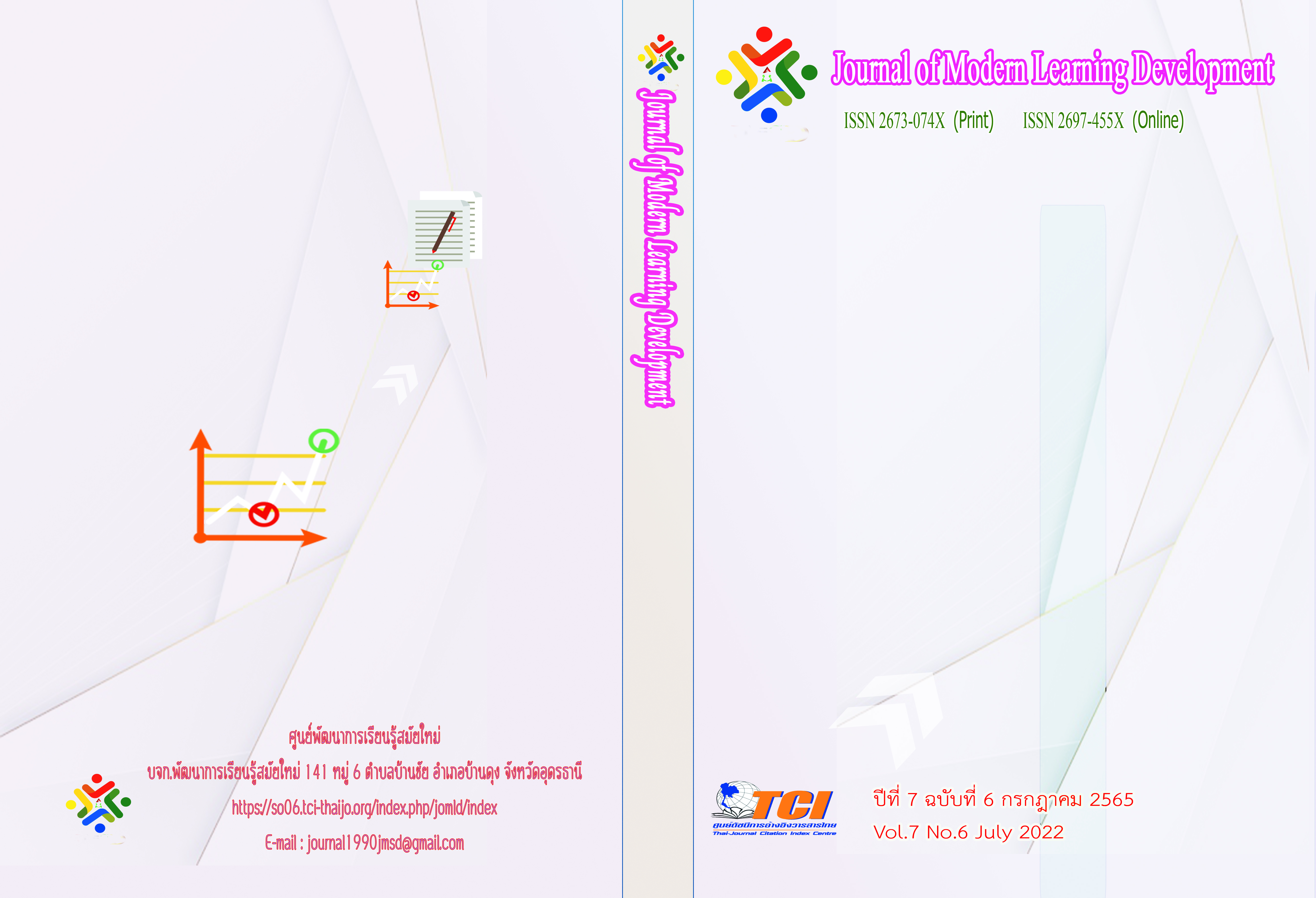การพัฒนาความสามารถการอ่านอย่างมีวิจารณญาณของนักเรียนชั้นมัธยมศึกษา ปีที่ 3 โดยใช้การจัดการเรียนรู้แบบปรากฏการณ์เป็นฐาน ร่วมกับแนวคิดแบบหมวกหกใบ
Main Article Content
บทคัดย่อ
การวิจัยครั้งนี้มีจุดมุ่งหมายคือ 1) เพื่อเปรียบเทียบความสามารถการอ่านอย่างมีวิจารณญาณของนักเรียนชั้นมัธยมศึกษาปีที่ 3 ก่อนและหลังการจัดการเรียนรู้โดยใช้ปรากฎการณ์เป็นฐานร่วมกับแนวคิดหมวกหกใบ 2) เพื่อศึกษาความพึงพอใจของนักเรียนชั้นมัธยมศึกษาปีที่ 3 ที่ได้รับการจัดการเรียนรู้โดยใช้ปรากฎการณ์เป็นฐานร่วมกับแนวคิดหมวกหกใบ โดยดำเนินตามกระบวนการวิจัย 2 ขั้นตอน คือ 1) เปรียบเทียบความสามารถการอ่านอย่างมีวิจารณญาณก่อนและหลังการจัดการเรียนรู้โดยการจัดการเรียนรู้แบบปรากฏการณ์เป็นฐานร่วมกับแนวคิดหมวกหกใบ 2) ศึกษาความพึงพอใจของนักเรียนที่ได้รับการจัดการเรียนรู้โดยการจัดการเรียนรู้แบบปรากฏการณ์เป็นฐานร่วมกับแนวคิดหมวกหกใบ กลุ่มตัวอย่าง ได้แก่ นักเรียนชั้นมัธยมศึกษาปีที่ 3 ภาคเรียนที่ 2 ปีการศึกษา 2564 โรงเรียนวัดเขารวก อำเภอตะพานหิน จังหวัดพิจิตร จำนวน 1 ห้องเรียน นักเรียนจำนวน 19 คน ได้มาโดยวิธีการสุ่มแบบเจาะจง เครื่องมือที่ใช้ในการวิจัย ได้แก่ 1) แผนการจัดการเรียนรู้การพัฒนาความสามารถการอ่านอย่างมีวิจารณญาณของนักเรียนชั้นมัธยมศึกษาปีที่ 3 2) แบบทดสอบวัดความสามารถการอ่านอย่างมีวิจารณญาณ 3) แบบวัดความพึงพอใจของนักเรียนที่ได้รับการจัดการเรียนรู้แบบปรากฏการณ์เป็นฐานร่วมกับแนวคิดหมวกหกใบ
ผลการวิจัยพบว่า
1.ผลการวัดความสามารถการอ่านอย่างมีวิจารณญาณ ของนักเรียนชั้นมัธยมศึกษาปีที่ 3 มีคะแนนหลังเรียนสูงกว่าก่อนเรียนอย่างมีนัยสำคัญทางสถิติที่ระดับ .05
2.ผลการศึกษาความพึงพอใจของนักเรียนชั้นมัธยมศึกษาปีที่ 3 มีความพึงพอใจอยู่ในระดับมากที่สุด
Article Details
เอกสารอ้างอิง
ทิวาร์ ศรนรินทร์. (2558). การเปรียบเทียบการคิดวิจารณญาณและผลสัมฤทธิ์ทางการเรียนของนักเรียนชั้นมัธยมศึกษาปีที่ 3 ระหว่างวิธีการจัดการเรียนรู้โดยใช้เทคนิคหมวกหกใบกับผังกราฟิก. วิทยานิพนธ์ ค.ม. (หลักสูตรและการสอน). บัณฑิตวิทยาลัย: มหาวิทยาลัยราชภัฏรําไพพรรณี.
ทัณฑธร จุ้ยสวัสดิ์. (2564). การพัฒนาผลสัมฤทธิ์ทางการเรียนและทักษะการคิดอย่างมี วิจารณญาณของนักเรียนชั้นมัธยมศึกษาปีที่ 5 ด้วยการจัดการเรียนรู้โดยใช้ปรากฏการณ์เป็นฐาน.การศึกษามหาบัณฑิต. บัณฑิตวิทยาลัย: มหาวิทยาลัยบูรพา.
เนาวนิตย์ สงคราม. (2556). การสร้างนวัตกรรมเปลี่ยนผู้เรียนให้เป็นสร้างนวัตกรรมจากงานวิจัยสู่การปฏิบัติ. กรุงเทพมหานคร: จุฬาลงกรณ์มหาวิทยาลัย.
พงศธร มหาวิจิตร. (2562). การประยุกต์ใช้แนวคิดการเรียนรู้โดยใช้ปรากฏการณ์เป็นฐานร่วมกับการเรียนรู้แบบเชิงรุกในรายวิชาการประถมศึกษาเพื่อเสริมสร้างทักษะ การเรียนรู้ในศตวรรษที่ 21. วารสารศึกษาศาสตร์ มหาวิทยาลัยขอนแก่น. 42 (2), 73-90.
ยุพาวดี มหาหิงค์. (2557). การพัฒนากิจกรรมการเรียนรู้แบบผสมผสารร่วมกับหมวกความคิด 6 ใบ เพื่อ ส่งเสริมความสามารถในการคิดอย่างมีวิจารณญาณ สำหรับนักเรียนชั้นประถมศึกษาปี ที่5. กศ.ม สาขาวิชาหลักสูตรและการสอน. บัณฑิตวิทยาลัย: มหาวิทยาลัยนเรศวร.
วิริยา วิริยารัมภะ. (2551). การเปรียบเทียบผลสัมฤทธิ์การอ่านอย่างมีวิจารณญาณ ของนักเรียนชั้น มัธยมศึกษาปีที่ 2 ที่สอนโดยใช้เทคนิคการคิดแบบหมวกหกใบ และวิธีสอนแบบปกติ.นครปฐม : สาขาวิชาการสอนภาษาไทย ภาควิชาหลักสูตรและวิธีสอน บัณฑิตวิทยาลัย: มหาวิทยาลัยศิลปากร.
Silander, P. (2015). Phenomenon – Based Learning: การเรียนรู้โดยใช้ปรากฏการณ์เป็นฐาน. แปลจาก How to create the school of the future: revolutionary thinking and design from Finland. แปลโดย เรวณี ชัยเชาวรัตน์. ออนไลน์. สืบค้น 17 กรกฎาคม 2564. แหล่งที่มา: https://thepotential.org/knowledge/phenomenon-based-learning/


